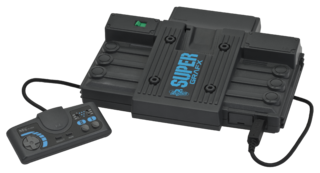PC Engine SuperGrafx
From NEC Retro
Revision as of 16:09, 23 December 2017 by AllisonKidd (talk | contribs)

| |||||||||||||||
| PC Engine SuperGrafx | |||||||||||||||
|---|---|---|---|---|---|---|---|---|---|---|---|---|---|---|---|
| Manufacturer: NEC | |||||||||||||||
|
This short article is in need of work. You can help NEC Retro by adding to it.
The PC Engine SuperGrafx (PCエンジンスーパーグラフィックス), commonly referred to simply as the SuperGrafx (スーパーグラフィックス) is a video game console released by NEC in November 1989.
The SuperGrafx was developed as an upgrade to the already successful PC Engine in Japan, aiming to be a "true" 16-bit console capable of competing against newer rivals, the Sega Mega Drive and likely the then-upcoming Neo Geo by SNK and Nintendo's Super Famicom (as well as various Japanese computers).
Contents
Hardware
Unlike the CD-ROM² and successive CD-based formats, the SuperGrafx is an entirely separate, stand-alone system with its own library of games. It is, however, backwards compatible with virtually all PC Engine software and peripherals (including the CD-ROM² player and Interface Unit via the ROM² Adaptor), so does not represent the fundamental change seen in the PC Engine's successor, the PC-FX.
The SuperGrafx brings to the table graphical enhancements over the original PC Engine hardware. It has four times the amount of working RAM, a second video chip (with its own video RAM) and priority controller chip which allows the two video chips to work together. Aside from these changes, the SuperGrafx is largely identical, save for its aesthetics, to a regular PC Engine console - it continues to have only one controller port, and all SuperGrafx games were distributed on HuCards.
Technical specifications
History
Development
Release
Legacy
Lack of interest in the SuperGrafx due to its high price and modest improvements over the PC Engine led to only seven games being produced for the system, only five of which demand SuperGrafx hardware in order to run. The system was discontinued within a year, becoming the least successful video game format to be released by NEC, while the console it was designed to replace, the PC Engine, was supported well into the 1990s.
It is debatable whether the SuperGrafx was ever a truly competitive video game console. The game that came to define the hardware, a port of Capcom's Daimakaimura released in 1990, for example, offers only minor improvements over its older and cheaper Mega Drive counterpart. However, the relative obscurity of the system and its lack of software makes everything SuperGrafx-related a highly sought-after prize for collectors.
Software
(* games which are enhanced by SuperGrafx hardware, but will continue to function in a regular PC Engine).
Magazine articles
- Main article: PC Engine SuperGrafx/Magazine articles.
